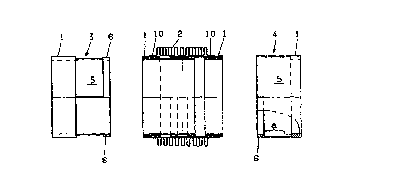Some of the information on this Web page has been provided by external sources. The Government of Canada is not responsible for the accuracy, reliability or currency of the information supplied by external sources. Users wishing to rely upon this information should consult directly with the source of the information. Content provided by external sources is not subject to official languages, privacy and accessibility requirements.
Any discrepancies in the text and image of the Claims and Abstract are due to differing posting times. Text of the Claims and Abstract are posted:
| (12) Patent Application: | (11) CA 2292767 |
|---|---|
| (54) English Title: | AXIAL COMPENSATOR |
| (54) French Title: | COMPENSATEUR AXIAL |
| Status: | Deemed Abandoned and Beyond the Period of Reinstatement - Pending Response to Notice of Disregarded Communication |
| (51) International Patent Classification (IPC): |
|
|---|---|
| (72) Inventors : |
|
| (73) Owners : |
|
| (71) Applicants : |
|
| (74) Agent: | BORDEN LADNER GERVAIS LLP |
| (74) Associate agent: | |
| (45) Issued: | |
| (86) PCT Filing Date: | 1998-05-09 |
| (87) Open to Public Inspection: | 1998-12-03 |
| Availability of licence: | N/A |
| Dedicated to the Public: | N/A |
| (25) Language of filing: | English |
| Patent Cooperation Treaty (PCT): | Yes |
|---|---|
| (86) PCT Filing Number: | PCT/EP1998/002719 |
| (87) International Publication Number: | EP1998002719 |
| (85) National Entry: | 1999-11-29 |
| (30) Application Priority Data: | ||||||
|---|---|---|---|---|---|---|
|
The invention relates to axial compensators for use especially in pipes
suitable for carrying gaseous and liquid media, essentially comprising at
least one compensator made of corrugated tube and arranged between two
connecting sleeves embodied as welded ends and having internal, tubular,
corresponding guide parts which can slide into each other and be connected to
the connecting sleeves. To alleviate pipe load during variations in length,
for example because of compressive or tensile stress, and to allow for
precisely definable movements even with small transfer forces the two guide
parts (3, 4) which can be slid into each other at each end have at least two
flange-like spacing studs (6) situated opposite each other, which spacing
studs (6) have a smaller angle at circumference (.beta.) than the openings (7)
provided for between the spacing studs (6) and said spacing studs (6), which
are brought into their final position by rotation in accordance with their
angle at circumference (.beta.), limit the length of the sliding run (a).
Compensateur axial destiné notamment à des conduites appropriées pour le transport de milieux gazeux et liquides, comprenant essentiellement au moins un compensateur à tube ondulé disposé entre deux tubulures de conduites réalisées sous forme d'extrémités soudées, et munies de guides tubulaires intérieurs correspondants s'emboîtant entre eux. En vue d'équilibrer la conduite lors de variations de longueur consécutives, par exemple, à des efforts de compression ou de traction, ainsi que pour permettre des déplacements rigoureusement définis, même à de faibles contraintes de transfert, les guides coulissant mutuellement (3, 4) sont munis chacun à leurs extrémités, d'au moins deux tenons d'écartement en forme de brides (6), opposés l'un à l'autre, Les tenons d'écartement (6) présentent un angle périphérique (.beta.) inférieur aux ouvertures (7) prévues entre les tenons d'écartement (6), cependant que lesdits tenons, amenés par rotation en leur position finale, de manière correspondant à leur angle périphérique (.beta.), délimitent le parcours de déplacement (a).
Note: Claims are shown in the official language in which they were submitted.
Note: Descriptions are shown in the official language in which they were submitted.

2024-08-01:As part of the Next Generation Patents (NGP) transition, the Canadian Patents Database (CPD) now contains a more detailed Event History, which replicates the Event Log of our new back-office solution.
Please note that "Inactive:" events refers to events no longer in use in our new back-office solution.
For a clearer understanding of the status of the application/patent presented on this page, the site Disclaimer , as well as the definitions for Patent , Event History , Maintenance Fee and Payment History should be consulted.
| Description | Date |
|---|---|
| Inactive: IPC from MCD | 2006-03-12 |
| Application Not Reinstated by Deadline | 2003-05-09 |
| Time Limit for Reversal Expired | 2003-05-09 |
| Deemed Abandoned - Failure to Respond to Maintenance Fee Notice | 2002-05-09 |
| Inactive: Cover page published | 2000-02-03 |
| Inactive: IPC assigned | 2000-02-02 |
| Inactive: First IPC assigned | 2000-02-02 |
| Inactive: Notice - National entry - No RFE | 2000-01-20 |
| Application Received - PCT | 2000-01-17 |
| Application Published (Open to Public Inspection) | 1998-12-03 |
| Abandonment Date | Reason | Reinstatement Date |
|---|---|---|
| 2002-05-09 |
The last payment was received on 2000-11-21
Note : If the full payment has not been received on or before the date indicated, a further fee may be required which may be one of the following
Patent fees are adjusted on the 1st of January every year. The amounts above are the current amounts if received by December 31 of the current year.
Please refer to the CIPO
Patent Fees
web page to see all current fee amounts.
| Fee Type | Anniversary Year | Due Date | Paid Date |
|---|---|---|---|
| Basic national fee - small | 1999-11-29 | ||
| MF (application, 2nd anniv.) - small | 02 | 2000-05-09 | 2000-04-19 |
| MF (application, 3rd anniv.) - small | 03 | 2001-05-09 | 2000-11-21 |
Note: Records showing the ownership history in alphabetical order.
| Current Owners on Record |
|---|
| HANS RATTAY |
| Past Owners on Record |
|---|
| None |